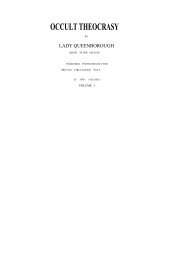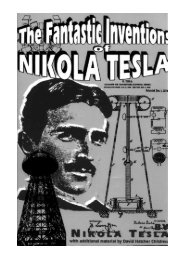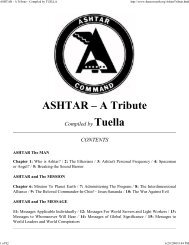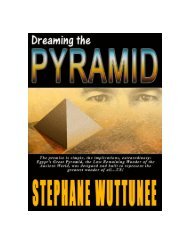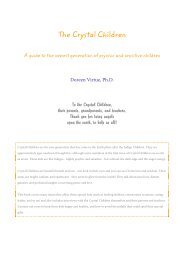the fantastic inventions of nikola tesla - Exopolitics Hong Kong
the fantastic inventions of nikola tesla - Exopolitics Hong Kong
the fantastic inventions of nikola tesla - Exopolitics Hong Kong
You also want an ePaper? Increase the reach of your titles
YUMPU automatically turns print PDFs into web optimized ePapers that Google loves.
emit relatively less visible and more invisible waves than before. Thus it would seem that when a platinum wire,<br />
for instance, is fused by currents alternating with extreme rapidity, it emits at <strong>the</strong> point <strong>of</strong> fusion less light and more<br />
invisible radiation than it does when melted by a steady current, though <strong>the</strong> total energy used up in <strong>the</strong> process <strong>of</strong><br />
fusion is <strong>the</strong> same in both cases. Or, to cite ano<strong>the</strong>r example, a lamp filament is not capable <strong>of</strong> withstanding as long<br />
with currents <strong>of</strong> extreme frequency as it does with steady currents, assuming that it be worked at <strong>the</strong> same luminous<br />
intensity. This means that for rapidly alternating currents <strong>the</strong> filament should be shorter and thicker. The higher <strong>the</strong><br />
frequency—that is, <strong>the</strong> greater <strong>the</strong> departure from <strong>the</strong> steady flow—<strong>the</strong> worse it would be for <strong>the</strong> filament. But if<br />
<strong>the</strong> truth <strong>of</strong> this remark were demonstrated, it would be erroneous to conclude that such a refractory button as used<br />
in <strong>the</strong>se bulbs would be deteriorated quicker by currents <strong>of</strong> extremely high frequency than by steady or low<br />
frequency currents. From experience I may say that just <strong>the</strong> opposite holds good: <strong>the</strong> button withstands <strong>the</strong><br />
bombardment better with currents <strong>of</strong> very high frequency. But this is due to <strong>the</strong> fact that a high frequency discharge<br />
passes through a rarefied gas with much greater freedom than a steady or low frequency discharge, and this will say<br />
that with <strong>the</strong> former we can work with a lower potential or with a less violent impact. As long, <strong>the</strong>n, as <strong>the</strong> gas is <strong>of</strong><br />
no consequence, a steady or low frequency current is better; but as soon as <strong>the</strong> action <strong>of</strong> <strong>the</strong> gas is desired and important,<br />
high frequencies are preferable.<br />
In <strong>the</strong> course <strong>of</strong> <strong>the</strong>se experiments a great many trials were made with all kinds <strong>of</strong> carbon buttons. Electrodes made<br />
<strong>of</strong> ordinary carbon buttons were decidedly more durable when <strong>the</strong> buttons were obtained by <strong>the</strong> application <strong>of</strong><br />
enormous pressure. Electrodes prepared by depositing carbon in well known ways did not show up well; <strong>the</strong>y<br />
blackened <strong>the</strong> globe very quickly. From many experiences I conclude that lamp filaments obtained in this manner<br />
can be advantageously used only with low potentials and low frequency currents. Some kinds <strong>of</strong> carbon withstand<br />
so well that, in order to bring <strong>the</strong>m to <strong>the</strong> point <strong>of</strong> fusion, it is necessary to employ very small buttons. In this case<br />
<strong>the</strong> observation is rendered very difficult on account <strong>of</strong> <strong>the</strong> intense heat produced. Never<strong>the</strong>less <strong>the</strong>re can be no<br />
doubt that all kinds <strong>of</strong> carbon are fused under <strong>the</strong> molecular bombardment, but <strong>the</strong> liquid state must be one <strong>of</strong> great<br />
instability. Of all <strong>the</strong> bodies tried <strong>the</strong>re were two which withstood best—diamond and carborundum. These two<br />
showed up about equally, but <strong>the</strong> latter was preferable, for many reasons. As it is more than likely that this body is<br />
not yet generally known, I will venture to call your attention to it.<br />
It has been recently produced by Mr. E. G. Acheson, <strong>of</strong> Monongahela City, Pa., U. S. A. It is intended to replace<br />
ordinary diamond powder for polishing precious stones, etc., and I have been informed that it accomplishes this<br />
object quite successfully. I do not know why <strong>the</strong> name "carborundum" has been given to it, unless <strong>the</strong>re is<br />
something in <strong>the</strong> process <strong>of</strong> its manufacture which justifies this selection. Through <strong>the</strong> kindness <strong>of</strong> <strong>the</strong> inventor, I<br />
obtained a short while ago some samples which I desired to test in regard to <strong>the</strong>ir qualities <strong>of</strong> phosphorescence and<br />
capability <strong>of</strong> withstanding high degrees <strong>of</strong> heat.<br />
Carborundum can be obtained in two forms—in <strong>the</strong> form <strong>of</strong> "crystals" and <strong>of</strong> powder. The former appear to <strong>the</strong><br />
naked eye dark colored, but are very brilliant; <strong>the</strong> latter is <strong>of</strong> nearly <strong>the</strong> same color as ordinary diamond powder, but<br />
very much finer. When viewed under a microscope <strong>the</strong> samples <strong>of</strong> crystals given to me did not appear to have any<br />
definite form, but ra<strong>the</strong>r resembled pieces <strong>of</strong> broken up egg coal <strong>of</strong> fine quality. The majority were opaque, but<br />
<strong>the</strong>re were some which were transparent and colored. The crystals are a kind <strong>of</strong> carbon containing some impurities,<br />
<strong>the</strong>y are extremely hard, and withstand for a long time even an oxygen blast. When <strong>the</strong> blast is directed against<br />
<strong>the</strong>m <strong>the</strong>y at first form a cake <strong>of</strong> some compactness, probably in consequence <strong>of</strong> <strong>the</strong> fusion <strong>of</strong> impurities <strong>the</strong>y<br />
contain. The mass withstands for a very long time <strong>the</strong> blast without fur<strong>the</strong>r fusion ; but a slow Carrying <strong>of</strong>f, or<br />
burning, occurs, and, finally, a small quantity <strong>of</strong> a glass-like residue is left, which, I suppose, is melted alumina.<br />
When compressed strongly <strong>the</strong>y conduct very well, but not as well as ordinary carbon. The powder, which is<br />
obtained from <strong>the</strong> crystals in some way, is practically non-conducting. It affords a magnificent polishing material<br />
for stones.<br />
The time has been too short to make a satisfactory study <strong>of</strong> <strong>the</strong> properties <strong>of</strong> this product, but enough experience<br />
has been gained in a few weeks I have experimented upon it to say that it does possess some remarkable properties<br />
in many respects. It withstands excessively high degrees <strong>of</strong> heat, it is little deteriorated by molecular bombardment,<br />
and it does not blacken <strong>the</strong> globe as ordinary carbon does. The only difficulty which I have found in its use in<br />
connection with <strong>the</strong>se experiments was to find some binding material which would resist <strong>the</strong> heat and <strong>the</strong> effect <strong>of</strong><br />
<strong>the</strong> bombardment as successfully as carborundum itself does.<br />
I have here a number <strong>of</strong> bulbs which I have provided with buttons <strong>of</strong> carborundum. To make such a button <strong>of</strong><br />
carborundum crystals I proceed in <strong>the</strong> following manner: I take an ordinary lamp filament and dip its point in tar, or<br />
some o<strong>the</strong>r thick substance or paint which maybe readily carbonized. I next pass <strong>the</strong> point <strong>of</strong> <strong>the</strong> filament through<br />
<strong>the</strong> crystals, and <strong>the</strong>n hold it vertically over a hot plate. The tar s<strong>of</strong>tens and forms a drop on <strong>the</strong> point <strong>of</strong> <strong>the</strong><br />
filament, <strong>the</strong> crystals adhering to <strong>the</strong> surface <strong>of</strong> <strong>the</strong> drop. By regulating <strong>the</strong> distance from <strong>the</strong> plate <strong>the</strong> tar is slowly



